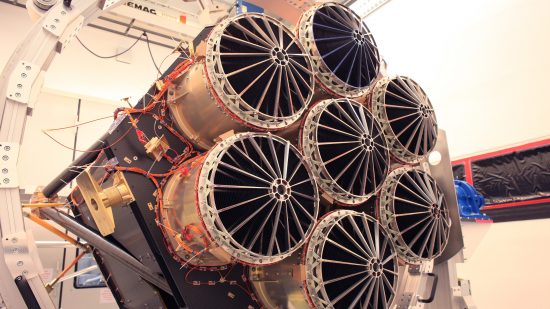
Sep 25, 2019
Still seeking the dark energy chimera.
On 13 July 2019 after a launch postponement of several weeks, a Proton-M rocket took off from the Baikonur spaceport in Kazakhstan. On board was the Russian-German satellite Spectrum-Roentgen-Gamma (SRG). SRG will orbit the Earth at Lagrange Point 2 (L2) at a distance of 1.5 million kilometers. In addition to the Russian ART-XC telescope, the satellite’s main instrument will be the extended ROentgen Survey with an Imaging Telescope Array or eROSITA for short. The innovative telescope will study the universe in the range from 0.3 to 11 thousand electron volts, in the highest spectral and spatial resolution, producing a map of all hot X-ray sources.
The eROSITA telescope consists of seven identical Wolter-1 mirror modules. These, in turn, each contain 54 gold-plated mirror shells nested one inside the other. Special challenges for the development team around Dr. Peter Predehl from the Max Planck Institute for Extraterrestrial Physics in Garching near Munich were two extreme design requirements. The X-rays may only hit the reflectors at a flat angle of a maximum of one degree and the so-called surface roughness of the mirror may not exceed a few millionths of a millimeter.
Among eROSITA’s goals are observations of up to 100,000 galaxy clusters and groups. along with the hot gases in filaments between clusters. Furthermore, it will detect all black holes in nearby galaxies, with up to 3 million new active galactic nuclei in distant galaxies. It will also scan for X-ray sources in the Milky Way, like supernova remnants, X-ray binaries and proto-stars.
This scientific survey also serves a higher purpose. After the observations of Type 1a supernovae by Perlmutter, Riess, and Schmidt, who were honored with the Nobel prize later, astronomers from the scientific mainstream believe that the universe will expand with ever-increasing speed. This leads to the question, which energy is strong enough to expand the universe against the effect of its own gravity? They have no answer to this question, therefore they call the unknown, supposed accelerator of the expansion of the universe, “dark energy”.
Dr. Predehl from the Max Planck Institute rightly said:
“Dark means here: We don’t know…I don’t want to say that we will solve the mystery of this dark energy, but we are at least on the trail of it.”
Dr. Thomas Mernik of the German Aerospace Center (DLR) in Bonn hoped that eROSITA would provide observations of the movements and speed of galaxy clusters, from which the researchers would be able to draw conclusions about the nature of Dark Energy. Finally, Dr. Walter Pelzer, member of the executive board of the DLR, was very optimistic and emphasized:
“In particular the German telescope will help to solve the enigma of dark energy.”
The design and manufacture of eROSITA represent a scientific and technical pioneering achievement, and it is rightly regarded as the most important prestige object of German astronautics. However, already in 2006, a Thunderbolts Picture of the Day headed The Ever-Elusive “Dark Energy“ characterized the invention of dark energy as a last resort, preventing the complete collapse of modern cosmology.
The results that eROSITA will deliver in the coming years will, no doubt, continue to be misinterpreted due to a completely outdated paradigm. Nevertheless, despite all resistance, dark energy, together with its “twin brother”, dark matter, will collapse under the burden of ever new discoveries of electromagnetic nature. Perhaps even some of eROSITAs future discoveries will help to open the eyes of more and more astronomers and astrophysicists and let them realize that we live in an Electric Universe.
Dr. Hannes Täger
The Thunderbolts Picture of the Day is generously supported by the Mainwaring Archive Foundation.












